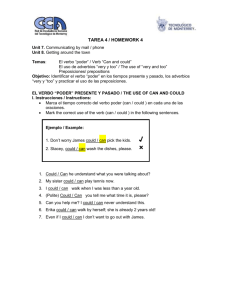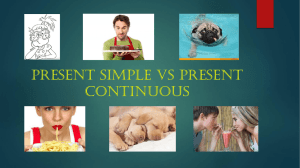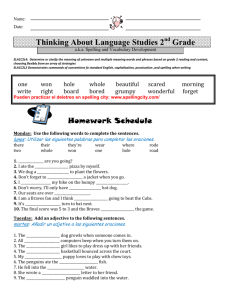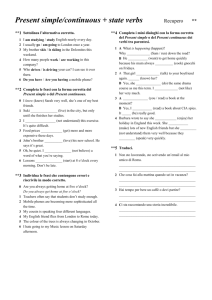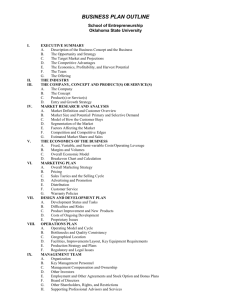SCHOOL: NAME: PREVIEW El verbo 'to be' es uno de los verbos
advertisement
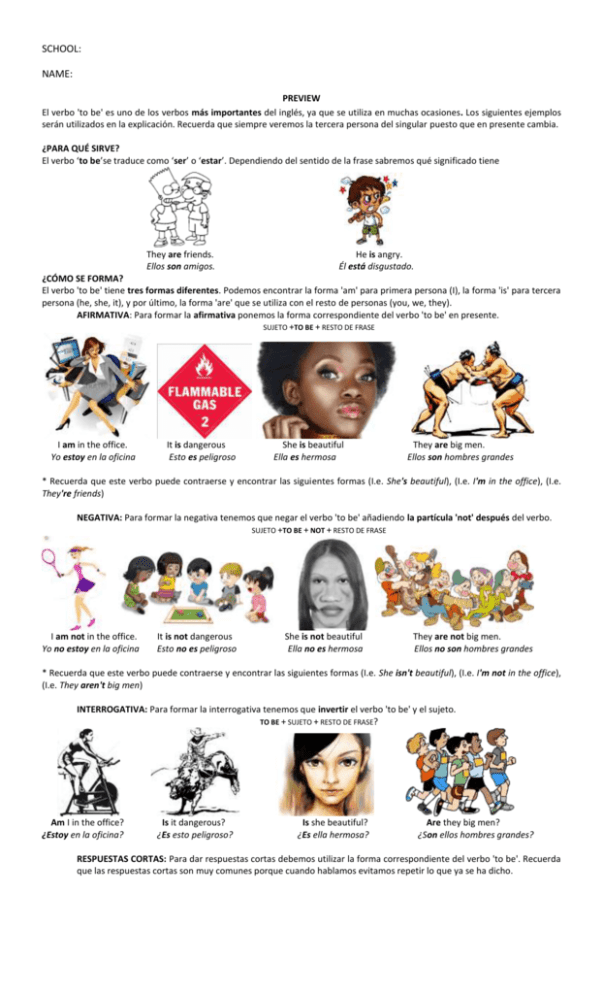
SCHOOL: NAME: PREVIEW El verbo 'to be' es uno de los verbos más importantes del inglés, ya que se utiliza en muchas ocasiones. Los siguientes ejemplos serán utilizados en la explicación. Recuerda que siempre veremos la tercera persona del singular puesto que en presente cambia. ¿PARA QUÉ SIRVE? El verbo ‘to be’se traduce como ‘ser’ o ‘estar’. Dependiendo del sentido de la frase sabremos qué significado tiene They are friends. Ellos son amigos. He is angry. Él está disgustado. ¿CÓMO SE FORMA? El verbo 'to be' tiene tres formas diferentes. Podemos encontrar la forma 'am' para primera persona (I), la forma 'is' para tercera persona (he, she, it), y por último, la forma 'are' que se utiliza con el resto de personas (you, we, they). AFIRMATIVA: Para formar la afirmativa ponemos la forma correspondiente del verbo 'to be' en presente. SUJETO +TO BE + RESTO DE FRASE I am in the office. Yo estoy en la oficina It is dangerous Esto es peligroso She is beautiful Ella es hermosa They are big men. Ellos son hombres grandes * Recuerda que este verbo puede contraerse y encontrar las siguientes formas (I.e. She's beautiful), (I.e. I'm in the office), (I.e. They're friends) NEGATIVA: Para formar la negativa tenemos que negar el verbo 'to be' añadiendo la partícula 'not' después del verbo. SUJETO +TO BE + NOT + RESTO DE FRASE I am not in the office. Yo no estoy en la oficina It is not dangerous Esto no es peligroso She is not beautiful Ella no es hermosa They are not big men. Ellos no son hombres grandes * Recuerda que este verbo puede contraerse y encontrar las siguientes formas (I.e. She isn't beautiful), (I.e. I'm not in the office), (I.e. They aren't big men) INTERROGATIVA: Para formar la interrogativa tenemos que invertir el verbo 'to be' y el sujeto. TO BE + SUJETO + RESTO DE FRASE? Am I in the office? ¿Estoy en la oficina? Is it dangerous? ¿Es esto peligroso? Is she beautiful? ¿Es ella hermosa? Are they big men? ¿Son ellos hombres grandes? RESPUESTAS CORTAS: Para dar respuestas cortas debemos utilizar la forma correspondiente del verbo 'to be'. Recuerda que las respuestas cortas son muy comunes porque cuando hablamos evitamos repetir lo que ya se ha dicho. Are they friends? Yes, they are. No, they are not. Son ellos amigos? Si, ellos lo son. No, ellos no lo son. Is she upset? Yes, she is. No, she is not. Está ella disgustada? Sí, ella lo está. No, ella no lo está. * Debes tener en cuenta que utilizamos la forma completa en las respuestas cortas afirmativas, mientras que utilizamos la forma contraída en las respuestas cortas negativas. ¿Qué debo recordar? Lo importante que debemos tener en cuenta es lo siguiente: Recuerda los pronombres personales (I, you, he, she, it, we, they), ya que son necesarios para conocer la forma que corresponde en cada caso. El verbo 'to be' tiene tres formas diferentes (am, is, are). Este verbo tiene formas contraídas para afirmativa y negativa que debemos recordar. Las preguntas se forman haciendo una inversión del verbo y el sujeto (aspecto importante porque siempre sucede en inglés). FORMA AFIRMATIVA FORMA NEGATIVA FORMA INTERROGATIVA I am (I'm) soy, estoy you are (you're) eres, estás he is (he's) él es, está we are (we're) somos, estamos you are (you're) eres, estás, son, están they are (they're) ellos son, están I am not (I'm not) no soy, no estoy you are not (you're not) no eres, no estás he is not (he's not) él no es, no está we are not (we're not) no somos, no estamos you are not (you're not) no eres, no estás, no son, no están they are not (they're not) ellos no son, no están am I? ¿soy yo?, ¿estoy yo? are you? ¿eres tú?, ¿estás tú? is he? ¿es él?, ¿está él? are we? ¿somos?, ¿estamos? are you? ¿eres?, ¿estás?, ¿son?, ¿están? are they? ¿son, están ellos? INTEGRATION ACTIVITIES ACTIVITY 1: Circle the correct option. (Encierra la opción correcta) 1. Sarah are / is / am big. 3. You are / is / am big. 2. Peter and Sarah are / is / am big. 4. I are / is / am big. 5. Peter and I are / is / am big. 5. Josh are / is / am big. ACTIVITY 2: Complete the sentences using AM, IS, ARE (Completa las oraciones usando AM, IS, ARE) 6. My green pencil _______ on the floor, 11. They _______ in London this 1. I _am__ a girl. too. week? 2. My father _______at work. 7. The other pencils _______ in my pencil 12. The pupils _______ not at school 3. Trixi and Felix _______ my cats. case. today. 4. Trixi _______ in the garden. 8. My mother _______ in the kitchen. 13. It _______Sunday. 5. Felix _______on the floor. 9. Susan and Betty _______ good friends. 14. I _______ at home. 10. They _______ good at sports. 15. We _______ friends. ACTIVITY 3: Write the pronouns (He, She, It, We, They) for these nouns. (Escribe los pronombres para estos sustantivos) Example: The man is at University = He is at university_____________________________________ 1. My friends are not in their houses. = _________________________________________________________ 2. The cat is very nice. = _________________________________________________________ 3. The woman is really pretty. = _________________________________________________________ 4. The cats are in the basket. = _________________________________________________________ 5. Those flowers aren't very big. = _________________________________________________________ 6. The pencil is really sharp. = _________________________________________________________ 7. You and I are not in the same classroom.= _________________________________________________________ 8. Sam and Paul aren't my brothers.= _________________________________________________________ 9. My mum and my dad are good to me.= _________________________________________________________ 10. 11. 12. 13. 14. 15. My dog isn't very young. = _________________________________________________________ The monster is green.= _________________________________________________________ The frogs are in the pond. = _________________________________________________________ Peter is my friend. = _________________________________________________________ Sophie isn't my cousin. = _________________________________________________________ My mother and I are very tall.= _________________________________________________________ ACTIVITY 4: Complete the conversations using the correct form or verb to BE. (Completa las conversaciones usando la forma correcta del verbo to BE) b) - Who___________ you? c) - Who John Roberts? a) - What ____is__your name? - I ___________John Roberts. - I___________ . - My name__is___ John Roberts. d) -___________ you John Roberts? - Yes, I___________ . e) - Who ___________she? - She___________ my wife. f) - Who___________ they? - They ___________ Mr. and Mrs. Roberts. ACTIVITY 5: Complete the sentences with the negative form or verb to BE. (Completa las oraciones con la forma negativa del verbo to BE) 11. Lucy (not/be) _____________from Australia. 1. I (not/be) ___am not___ cold. 12. I (not/be) _____________ a nurse. 2. She (not/be)_____________ French. 13. He (not/be) _____________sleepy. 3. You (not/be) _____________an accountant. 14. We (not/be) _____________at home. 4. John (not/be) _____________ my brother. 15. You (not/be) _____________ from China. 5. They (not/be) _____________ from Berlin. 16. They (not/be) _____________at school. 6. We (not/be) _____________late. 17. I (not/be) _____________hungry. 7. It (not/be) _____________warm outside. 18. Ian and Jill (not/be) _____________ on the bus. 8. He (not/be) _____________in the bathroom. 19. She (not/be) _____________Spanish. 9. We (not/be) _____________ thirsty. 20. You (not/be) _____________a teacher. 10. It (not/be) _____________ sunny. ACTIVITY 6: Complete the sentences with AM, AM NOT, IS, IS NOT, ARE, ARE NOT. Use real information. (Complete las oraciones con AM, AM NOT, IS, IS NOT, ARE, ARE NOT. Usa información real.) 4. We _____________ English. 7. He_____________ a nurse. 1. She ___is not ____ a boy. 5. They _____________ pencils. 8. You _____________ lazy pupils. 2. I _____________ a doctor. 6. It _____________ a book. 9. He _______________ my sister 3. You _____________ a dentist. ACTIVITY 7: Complete the sentences using AM, IS, ARE (Completa las oraciones usando AM, IS, ARE) 11. My name _______ Jonathan. 1. New York _is_ a very big city 12. I _____ eleven years old. 2. Buses in London _____ red 13. My sisters ______ ten and twenty years old. 3. ____ your house near here? 14. The climate _____ hot today 4. Where _____ you from? 15. My father and my mother ______ teachers. 5. Clara ____ single 16. I ______ hot. 6. My phone number ____ 5558963 17. I _____ a student and my older sister _____ a architect 7. I ____ from Italy 18. My dog ______ very big. 8. They _____ twins 19. These pencils ______ very old. 9. I _____ quite tall 20. Sarah ________ a very good student. 10. We ______ bored ACTIVITY 8: Circle the correct option to complete the sentences. (Encierra la opción correcta para completar las oraciones) Example: We ___ going to the station. a) am b) is c) are 1. She ______ from France. a) am b) is c) are 2. ______ you happy? a) am b) is c) are 3. You ______ not in my class. a) am b) is c) are 4. You and Tomas ______ right. a) am b) is c) are 5. Where ______ I? a) am b) is c) are 6. This ______ an Apple. a) am b) is c) are 7. The dogs ______ in the yard. a) am b) is c) are 8. Who ______ in the living room? a) am b) is c) are 9. 10. ______ I in your seat? a) am b) is c) are 11. Dave and Jane ______ in the kitchen. a) am b) is c) are 12. The baby ______ cute! a) am b) is c) are 13. Amir and I ______ in the same class. a) am b) is c) are 14. _____ Mr. Jones a teacher? a) am b) is c) are 15. These ______ apples. a) am b) is c) are How many people ______ in your class? a) am b) is c) are 16. He ___ a boy. a) am b) is c) are 17. I ___ going to the bus stop. a) am b) is c) are 18. She ___ my sister. a) am b) is c) are 19. John ___ absent. a) am b) is c) are 20. They ___ playing golf. a) am b) is c) are 21. I ___ hot. a) am b) is 22. Tom and Mary ___ late. a) am b) is c) are 23. It ___ very expensive. a) am b) is c) are 24. You ___ next. a) am b) is c) are c) are ACTIVITY 9: Organize the sentences. (Organiza las oraciones) Example: at / the top / new address / the / letter / is / / My / of __My new address is at the top of the letter___ 1. I / teacher / a / am. _______________________________________________________________________________ 2. are / a / You / student. _______________________________________________________________________________ 3. boy / He / is / a _______________________________________________________________________________ 4. a / girl / is / She _______________________________________________________________________________ 5. elephant / is / an / It _______________________________________________________________________________. 6. Spain / are / We / in _______________________________________________________________________________ 7. You / in / are / England _____________________________________________________________________________ 8. are / They / dogs_______________________________________________________________________________ 9. am / I / years old / twenty-five _________________________________________________________________________ 10. are / from / We / Venezuela __________________________________________________________________________ 11. Anton / and / name / My / a student / is / I'm ___________________________________________________________ 12. is / my / This / book _______________________________________________________________________________ 13. It's / day / a / today / nice ____________________________________________________________________________ 14. Paul / brother's / Her / name / is _______________________________________________________________________ 15. an / engineer / John / is _____________________________________________________________________________ 16. Jonathan / name / My / is_____________________________________________________________________ 17. my class / students / in / thirty / There are _____________________________________________________________ ACTIVITY 10: Complete the gaps with the negative forms of the verb to BE . (Completa los espacios con la forma negativa del verbo to BE) 5. We ___________ in England. Example: She is not from France. 6. It ___________ Monday today. 1. This book ___________ mine. 7. Jennie's surname ___________ Peters. 2. Jane and Peter ___________ married. 8. I ___________ a hairdresser. 3. That ___________ right. 9. My name ___________ Alexander. 4. My brother ___________ here at the moment. 10. There ___________ many people in this class. ACTIVITY 11: Write the opposite according to the picture. (Escribe el antónimo de acuerdo a los dibujos) short / __tall___ ______________ thin / ugly / / _____________ _______________ old / _____________ _________________ / safe ugly / ______________ stupid / ___________________ weak / ________________ quiet / _________________ / ______________ Dark / wide dirty / ____________________ ______________________ hard heavy / ______________ slow / ______________________ / ____________________________ ACTIVITY 12: Look at the picture. Read and complete the sentences with the affirmative or negative form of the verb to BE. (Mira los dibujos. Lee y completa las oraciones con la forma afirmativa o negativa del verbo to BE) 1. The dinosaur _is not___ green. It __is__ purple. 2. The frog ________ very cute. 3. The boys ________ under the snow. 4. The chick ________ very big. 6. The language teacher_______ tall. 7. The babies _________ in the kitchen. They_________ in the bathroom. 8. They_________ thin. They _________very very very fat. 9. The man _________relaxed . He _______very tired. 5. The man and the woman _________ very happy today. ACTIVITY 13: Circle the correct form of verb to BE to complete the questions. (Encierra la forma correcta del verbo to BE para completar las preguntas) 1. Am / Is / Are Jane and Alice sisters? 5. Am / Is / Are you twenty-five years old? 2. Am / Is / Are this car yours? 6. Am / Is / Are the Smiths divorced? 3. Am / Is / Are I in your way? 7. Am / Is / Are this your new bicycle? 4. Am / Is / Are Maria John's sister? ACTIVITY 14: Organize the questions correctly. (Organiza las preguntas correctamente) 1. you / hot? / Are ________________Are you hot?______________________________ 2. this / your / Is / book? ______________________________________________________________________ 3. the Unites States? / Mr. Peters / from / Is _____________________________________________________ 4. Are / married? / they ____________________________________________________________________________ 5. or / I / wrong? / Am / right ____________________________________________________________________ 6. your / Is / Sandra? / daughter's name ______________________________________________________________ 7. Mr. and Mrs. / you / Jenkins? / Are _________________________________________________________________ ACTIVITY 13: Circle the correct form of verb to BE to complete the sentences. (Encierra la forma correcta del verbo to BE para completar las oraciones) 1. Brian are / am / is in the kitchen. 6. They is / are / am in the restaurant. 2. I are not / is not / am not tall. 7. Are / Am / Is you Spanish ? 3. How are / am / is you? 8. I are / am / is a boy. 4. Am/ Is/ Are she Italian? 9. Am / Are / ls he in the USA? 5. We aren’t / ‘m not / isn’t slim. 10. You is / am / are a student. ACTIVITY 8: Circle the correct sentences. It could be 1 or several options. (Encierra las oraciones correctas. Pueden ser 1 o varias opciones. ) Sentence 1 a) I am not in the garden. c) I'm n't in the garden. b) I’m not in the garden. d) I' am not in the garden Sentence 2 a) Your parents are very tall? c) Your parents aren't very tall. b) Is your parents very tall? d) Your parents isn't very tall. Sentence 3 a) My exam is very easy. c) Are my exam very easy?. b) My exam is not very easy. d) Aren't my exam very easy?. Sentence 4 a) The babies're not very small. c) Is the babies very small? b) Isn't the babies very small?. d) The babies are very small. Sentence 5 a) The computers isn't broken. c) Are the computers broken?. b) The computers is broken. d) The computers is not broken. Sentence 6 a) The child are in his room. c) The child'snot in his room. b) The child is in his room. d) The child aren't in his room. ASSESMENT CRITERIA. 1 The student did not do any of the exercises correctly or completely. 2 The student did half of the exercises and most of the answers were incorrect. Verb to Be (Affirmative, Negative) The student did not do any of the exercises correctly or completely. The student did half of the exercises and most of the answers were incorrect Verb to Be (Questions, All sentences) The student did not do any of the exercises correctly or completely. The student did half of the exercises and most of the answers were incorrect Vocabulary Activities 3 The student did most of the exercises but most of the answers were incorrect or incomplete. The student did most of the exercises but most of the answers were incorrect or incomplete. The student did most of the exercises but most of the answers were incorrect or incomplete. 4 The student did most of the exercises but some answers were incorrect. 5 The student did all the exercises and most of the answers were correct. The student did most of the exercises but some answers were incorrect. The student did all the exercises and most of the answers were correct. The student did most of the exercises but some answers were incorrect. The student did all the exercises and most of the answers were correct.
